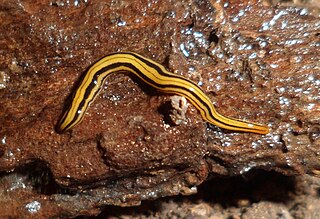
Luteostriata is a genus of land planarians from Brazil characterized by a yellow body with dark longitudinal stripes.

Obama is a genus of land planarians from South America. It contains several species adapted to human-disturbed environments, including the only invasive land planarian native to the Neotropical realm, Obama nungara, which has been accidentally introduced in Europe.

Cratera is a genus of land planarians found in South America.

Pasipha is a genus of land planarians from South America.

Endeavouria is a monotypic genus of land planarians from the Pacific region. It contains a single species, Endeavouria septemlineata.

Obama ladislavii is a species of Brazilian land planarian in the subfamily Geoplaninae. It is one of the most common land planarians in human-disturbed environments in southern Brazil and is easily identifiable by the green color of its dorsum.

Obama anthropophila is a species of Brazilian land planarian in the subfamily Geoplaninae. It is a very common land planarian in human-disturbed environments in southern and southeastern Brazil.

Obama ficki is a large species of Brazilian land planarian in the subfamily Geoplaninae.

Obama josefi is a species of Brazilian land planarian in the subfamily Geoplaninae.

Cratera ochra is a species of land planarian in the subfamily Geoplaninae. It is found in Brazil
Cratera nigrimarginata is a species of land planarian found in Brazil.
Cratera aureomaculata is a species of land planarian from Brazil.
Cratera anamariae is a species of land planarian belonging to the subfamily Geoplaninae. It is known from specimens found in Serra dos Órgãos National Park, Brazil.
Cratera steffeni is a species of land planarian belonging to the subfamily Geoplaninae. It is found in Rio Grande do Sul, Brazil.
Cratera taxiarcha is a species of land planarian belonging to the subfamily Geoplaninae. It is known from specimens found in Albert Löfgren State Park and Cantareira State Park in Brazil.
Cratera picuia is a species of land planarian belonging to the subfamily Geoplaninae. It is known from specimens found in Saint-Hilaire/Lange National Park in Brazil.
Cratera arucuia is a species of land planarian belonging to the subfamily Geoplaninae. It is known from specimens found in Intervales State Park in Brazil.
Imbira flavonigra is a species of land planarian belonging to the subfamily Geoplaninae. It is known from specimens found in Brazil.
Luteostriata subtilis is a species of land planarian belonging to the subfamily Geoplaninae. It is known from specimens found in Brazil.
Pasipha paucilineata is a species of land planarian belonging to the subfamily Geoplaninae. It is found within Brazil.









